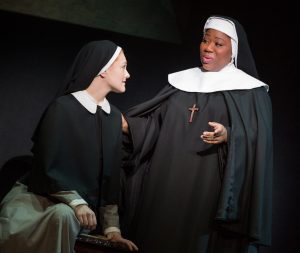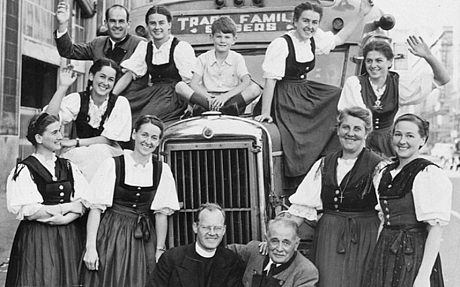Criminal ‘Sound of Music’ Has Way with Broadway SD
Broadway San Diego’s PR literature says The Sound of Music is the most successful movie musical of all time — but maybe that depends on how you define “successful.” Filmsite.org has it at No. 3 in domestic gross box office adjusted for inflation; tasteofcinema.com puts it at No. 6. Not too shabby, but still a little ways from the top.
Aside: When the movie was released in 1965, acclaimed film critic Pauline Kael called it “the sugar-coated lie that people seem to want to eat.” Walter Kerr said it was “[n]ot only too sweet for words but almost too sweet for music.” The hills were alive in those days, all right — and for some, Oscar Hammerstein II’s corpse was feeding the greenery, his libretto be hanged.

Maria (Kristen Anderson, shown, and Anna Mintzer on alternate nights) craves music, the outdoors and her God as holy testament to her love of life. Photo by Matthew Murphy.
But we’re talkin’ theater here, mister, with its wholly different demands on audience perception. The Sound of Music, in fact, was originally a 1959 Broadway entry, winning five of nine Tony Awards for Hammerstein and composer Richard Rodgers and cementing actor Mary Martin’s reputation along the way.
Almost 60 years later, director Jack O’Brien claims that his current Broadway San Diego turn is “deeper, richer and more powerful than ever” — and while that may be true in some respects, it also represents the closer relationship between theater and film. Underdeveloped subtext and threadbare dialogue have always dotted this criminally overrated piece in either medium; for our purposes, the salve for Wally’s and Pauline’s timeworn ire won’t be found onstage.
Y’all know the story, even if you haven’t seen the movie or the play: Maria Kutschera, plucky postulant at Salzburg’s Nonnberg Abbey, leaves her convent for a turn as governess to the seven children of widowered Austrian Navy officer Georg von Trapp. As she learns the ways of the world, the world seeks her in return; she and von Trapp marry, and their household reflects Maria’s love of life, music and the outdoors (the kids are an absolute hoot as the family’s singing becomes a cottage venture) — but Georg’s opposition to Hitler’s rise has caught the attention of the strongman’s henchmen.
The von Trapps flee the Austria of 1938 on the eve of the country’s Nazi annexation.
… [T]he topheavy reliance on the tunes makes this piece look and feel not so much like a musical as a revue.
History had put a certain distance between itself and Nazism by the time the musical opened in New York, and that’s certainly part of its appeal. And the von Trapps’ joyous resurgence after mom’s death (especially that of Georg, who’s found the courage to love again) is a sight to behold under O’Brien’s direction. It’s only when the wholesale nondescript dialogue kicks in that the evening wears down.
“You like children, and you’re very good with them”; “I shall be back in about a month”; “The first rule in this house is discipline”; “The love of a man and a woman is holy too”; “While you were gone, you received a call from Berlin”; “Since his wife died, his children remind him only of her”: Lines as unprosaic as that color nothing in the characters or in the action they fuel, and here, they’re par for the course.
Compare that with Rodgers’ lush use of fabric in the songs we’ve come to know (“The Sound of Music,” “Maria,” “My Favorite Things,” “Do-Re-Mi” and a million more), and the speeches become even more problematic. The first test of any good musical lies in the collaborative effort between music and the spoken word; here, the topheavy reliance on the tunes makes this piece look and feel not so much like a musical as a revue. The dialogue really is that bad.

Kindly counsel from the Mother Abbess (Melody Betts, right) falls on Maria’s eager ears. Photo by Matthew Murphy.
O’Brien, Tony winner and former Old Globe Theatre artistic director, has always had a solid big-picture approach to his logistics — and as often as not, that approach has worked against him. His stagings leave very little room for reference points; one song or point of phrase is as important as the next, often leaving a tune to compete within itself for stage time.
Meanwhile, don’t blame Anna Mintzer (the opening night performer) — her Maria is as fresh-faced and boundless as ever, the ideal complement to a once-weary Georg, played imposingly by Ben Davis. To every last person, the kids hold sway amid the chemistry Mintzer fuels. And dig Melody Betts as her great Mother Abbess belts “Climb Ev’ry Mountain” — you’ll absolutely leave your seat, and you’ll promptly forget where it is.
Broadway San Diego technical traditions abound here, with Douglas W. Schmidt’s movable set design ideal on the Civic Theare’s smallish stage. Natasha Katz gets a serious shout-out for her lights, whose optical illusions are handsomely in play. Danny Mefford choreographs and Andy Einhorn supervises music with the von Trapp kids’ exuberance; Jane Greenwood’s costumes and Ken Travis’ sound exude both utility and intent.
The masters exult in their commands, even as the dog is still a dog.

With Maria as its anchor, The von Trapp Family Singers did what they did best for a time.
You’re likely aware that The von Trapp Family Singers was a real-life concern — Maria’s bestselling memoirs chronicle the journeys, and it’s a cinch the book answers far more than the film and play.
Where, for example, were the von Trapps going when they left Austria? Stowe, Vt., where the family eventually ended up and the current home of Johannes, last surviving von Trapp? Fine — but the family picture is incomplete if we’re not given benefit of the information. The future of daughter Liesl’s love life? Cause of the first von Trapp wife’s death? Nazism’s social platform? And on and on? The show simply and undeniably leaves answers to chance, with Broadway San Diego left holding a bag that rightly belongs in Hammerstein’s cold, dead hands.
This review is based on the media night performance of Nov. 16. The Sound of Music runs through Nov. 20 at Civic Theatre, 1100 Third Ave. Downtown. $22.50-$102.50. (619) 570-1100, broadwaysd.com.

Martin Jones Westlin, principal at editorial consultancy Words Are Not Enough and La Jolla Village News editor emeritus, has been a theater critic and editor/writer for 25 of his 47 years…
More…


